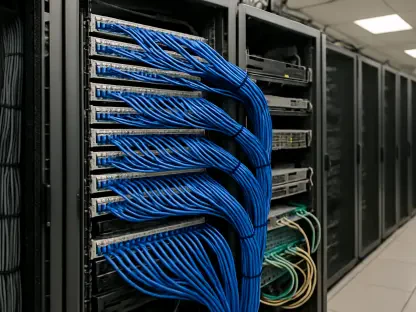The transformation of enterprise IT operations through AI-driven network automation has become a pivotal development in modern network management. As the pressure on enterprise IT infrastructures mounts with the exponential growth in data and the complexities of AI workloads, companies are turning to artificial intelligence to streamline and optimize their network functions. This integration promises not only to enhance efficiency and reduce manual intervention but also to ensure networks can meet the burgeoning demands of today’s data-driven environments.
The Transformation of Network Operations
AI is fundamentally altering the way enterprises manage their network operations, steering the industry towards more advanced, autonomous systems. Traditional network management, characterized by complex manual procedures and persistent troubleshooting efforts, is becoming a relic of the past. Instead, AI-driven network automation is providing a smarter, more streamlined approach. This radical shift allows IT teams to focus on strategic projects instead of being bogged down by the routine and painstaking nature of traditional network upkeep.
At the forefront of this revolution is Juniper Networks Inc., whose CEO Rami Rahim has been vocal about the critical role AI plays in modernizing infrastructure. As enterprise data demands soar, particularly with the explosion of AI applications, businesses need networks that are not only robust but intelligent and adaptive. AI integration within network management systems is proving instrumental in scaling infrastructure efficiently, managing large volumes of data without sacrificing performance, and thereby meeting the continued rise in digital demands.
Addressing the Rising Data Demands
One major challenge enterprises face today is the rampant growth of AI workloads, which necessitates innovative and sophisticated networking solutions. Traditional data centers are often ill-equipped to handle such an influx, leading to inefficiencies and bottlenecks. Enter technologies like liquid cooling, co-packaged optics, and high-performance fabrics, which provide necessary support to meet these increased data demands. These advanced solutions not only help in managing the data loads but also ensure sustainability and efficiency within enterprise networks.
To stay ahead, enterprises must make substantial investments in upgrading their networking infrastructure. This not only ensures they are capable of handling the vast data volumes needed for high-functioning AI applications but also fortifies against future data challenges. AI-driven network automation, therefore, is not just an incremental improvement but a fundamental shift required to sustain modern IT operations. It prepares enterprises to handle complex AI workloads by providing the capacity and speed necessary to manage extensive computational processes effectively.
Enhancing Efficiency and Resilience
Competing in today’s fast-paced market compels enterprises to bolster network efficiency, scalability, and resilience. AI stands at the center of this effort, offering solutions that significantly streamline network operations. Helping enterprises to support massive GPU clusters needed for rigorous AI computations, AI optimizes performance by automating standard tasks and reducing operational costs and downtime. This strategic advantage allows businesses to maintain their competitive edge by ensuring robust network functionality without the constant need for manual oversight.
The introduction of autonomous network management reduces the strain on IT teams, shifting their focus towards more critical and strategic initiatives. By automating routine troubleshooting and maintenance tasks, AI-driven solutions enhance network reliability and performance. Furthermore, this autonomy helps detect and resolve potential issues proactively, thus maintaining seamless operation and minimizing disruptions. Consequently, the operational efficiency of enterprises improves dramatically, paving the way for continuous innovation and growth within the field.
Investments in Advanced Networking Technologies
Supporting the extensive computational demands of AI necessitates significant investments in advanced networking technologies. Enterprises are revamping their infrastructure to include innovations that enhance power efficiency, manage congestion effectively, and provide the high-speed, high-capacity networks essential for seamless AI model training and inference operations. By investing in these cutting-edge technologies, businesses ensure they can maintain optimal performance while keeping pace with the ever-evolving landscape of AI applications.
These investments are not just about meeting current demands but about future-proofing enterprise IT operations. With the continuous evolution of AI, businesses must be prepared for the computational and networking challenges that lie ahead. Embracing AI-compatible infrastructures ensures that companies remain at the forefront of technological innovation, ready to capitalize on upcoming opportunities. Such forward-thinking strategies underline the importance of advanced network solutions in achieving long-term organizational success.
Competitive Differentiation Through Real-Time Management
The transformation of enterprise IT operations through AI-driven network automation is a key development in contemporary network management. With the rapid expansion in data and the complexities associated with AI workloads, pressure on enterprise IT infrastructures is escalating. To address these challenges, companies are increasingly adopting artificial intelligence to streamline and optimize their network functions. Integrating AI into network management systems promises to enhance operational efficiency, reduce the need for manual interventions, and ensure that networks are capable of meeting the increasing demands of today’s data-centric environments. This shift towards AI-driven automation is not just about keeping up with growing data volumes but also about anticipating future requirements and scaling network capacities accordingly. By leveraging AI, businesses can improve their IT infrastructure’s resilience, adaptability, and performance. Consequently, this evolution is set to redefine how organizations manage their networks, making them more robust, responsive, and prepared for the future.









